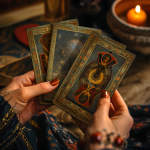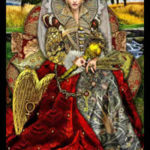Tarot cards have captivated human imagination for centuries, offering insights, guidance, and a way to tap into deeper layers of intuition. Whether you’re seeking clarity about your love life, career, or personal growth, learning how to read tarot cards can be a powerful and rewarding journey.
In this guide, you’ll learn the essentials of tarot reading — from understanding the cards, choosing your deck, and preparing for a reading, to interpreting the cards confidently. Let’s dive in!
What Is Tarot?
Tarot is a system of 78 cards, each filled with symbolic imagery that represents different aspects of the human experience. Contrary to popular belief, tarot doesn’t “predict” a fixed future. Instead, it acts as a mirror, reflecting back insights about your current path, energies, and potential outcomes.
The two main parts of a tarot deck are:
Major Arcana (22 cards): These represent big life themes and lessons (like The Fool, The Lovers, Death, and The World).
Minor Arcana (56 cards): These reflect day-to-day events and situations. They’re divided into four suits — Cups, Pentacles, Swords, and Wands — similar to playing cards.
Each card tells a story, and your job as a reader is to weave these stories together.
Step 1: Choose the Right Tarot Deck
Choosing a tarot deck is a personal process. While the Rider-Waite Tarot is the most traditional and beginner-friendly deck, there are thousands of beautiful, themed decks available today — from cosmic, to botanical, to gothic.
Tips for choosing your deck:
Go with your gut. Pick a deck you feel drawn to — the artwork and energy should “speak” to you.
Start simple. For beginners, decks with clear symbolism and a guidebook are helpful.
Don’t stress about tradition. There’s an old myth that you must be gifted your first deck. Ignore it — buy a deck you love.
Step 2: Get Familiar with the Cards
Before you do a full reading, spend time getting to know your deck.
Here are some ideas:
Touch and shuffle the cards regularly to build an energetic bond.
Pull a “Card of the Day” and journal what it could mean for you.
Study the meanings from the guidebook, but also pay attention to what your intuition says when you look at the card.
Pro Tip: Tarot is a blend of memorization and intuition. It’s not about reciting definitions but about feeling what the card means in the moment.
Step 3: Prepare for a Reading
Setting a clear and intentional space before reading tarot can make a huge difference in the quality of your insights.
Here’s how to prepare:
Clear your space. Light a candle, burn some incense, or play soft music to raise the energy.
Ground yourself. Take a few deep breaths and center your mind.
Ask a clear question. Tarot loves specific questions. Instead of “Will I be happy?” try “What steps can I take to find more happiness in my life?”
Examples of good questions:
“What should I know about my current relationship?”
“What energy surrounds my career path right now?”
“What lesson am I being asked to learn at this time?”
Step 4: Shuffle and Draw Your Cards
Shuffling is more than just mixing cards — it’s about focusing your intention into the deck.
Methods for shuffling:
Overhand shuffle (like regular playing cards)
Pile shuffle (mixing them around on a table)
Intuitive shuffle (stop when you feel “ready”)
Once shuffled, you can draw cards in several ways:
Single card draw for quick answers
Three-card spread for past/present/future
Celtic Cross spread for deep, layered insight
Three-Card Spread Example:
Past: What energy brought you here?
Present: What’s influencing you now?
Future: Where is the situation heading?
Step 5: Interpret the Cards
Here’s where magic and meaning come alive.
When interpreting a tarot card:
Look at the imagery. What’s the mood? What colors stand out?
Feel the emotional tone. Does it feel heavy? Light? Mysterious?
Blend traditional meanings with your gut feelings.
Example:
If you pull the Three of Swords, traditional meanings suggest heartbreak or betrayal. But if you’re asking about personal growth, it could also point to the pain of letting go to become stronger.
Don’t rush. Let the story unfold naturally.
Common Tarot Spreads for Beginners
Here are a few simple layouts to start practicing:
One-Card Reading:
Great for daily guidance or quick clarity.
Three-Card Reading:
Past / Present / Future
Mind / Body / Spirit
Situation / Challenge / Advice
Five-Card Cross:
Card 1: Present situation
Card 2: What’s crossing you (challenge)
Card 3: Underlying foundation
Card 4: Recent past
Card 5: Potential outcome
As you gain experience, you can make up your own spreads!
Tips for Becoming a Better Reader
Practice, practice, practice. The more you read, the sharper your intuition becomes.
Journal your readings. Write down your card pulls and impressions to track patterns over time.
Stay open-minded. Tarot readings aren’t always literal — sometimes the message becomes clear after a few days.
Respect the process. Treat each reading with care, even if you’re just reading for yourself.
Trust yourself. Your intuition is your strongest guide — not just the book meanings.
Common Mistakes to Avoid
Being too rigid. Tarot is an art, not an exact science.
Asking the same question repeatedly. Trust the first answer you get.
Fearing “bad” cards. Cards like Death, The Tower, and The Devil aren’t “bad” — they usually signal transformation, necessary endings, or personal growth.
Reading when emotional. Try to wait until you’re calm so your readings stay clear.
Final Thoughts
Learning to read tarot cards is like learning a new language — the language of the soul. It’s less about “fortune-telling” and more about empowerment, reflection, and personal insight.
Trust that the right card always comes at the right time.
The more you practice, the more confident and connected you’ll feel.
Whether you’re pulling a single card each morning or doing elaborate spreads under the full moon, tarot can become a beautiful, sacred ritual that deepens your self-awareness and intuition.
✨ Happy reading, and may your journey with the cards be magical and wise! ✨



